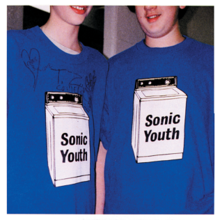| Washing Machine | ||||
|---|---|---|---|---|
 | ||||
| Studio album by | ||||
| Released | September 26, 1995 | |||
| Recorded | January – May 1995 | |||
| Studio | Easley Studios (Memphis, Tennessee) Mott and Greene Street Studios (New York City) | |||
| Genre | ||||
| Length | 68:17 | |||
| Label | DGC | |||
| Producer | Sonic Youth, John Siket | |||
| Sonic Youth chronology | ||||
| ||||
| Sonic Youth studio album chronology | ||||
| ||||
| Singles from Washing Machine | ||||
| ||||
| Music video | ||||
| "The Diamond Sea" on YouTube | ||||
| Music video | ||||
| "Little Trouble Girl" on YouTube | ||||
Washing Machine is the ninth studio album by the American experimental rock band Sonic Youth, released on September 26, 1995, by DGC Records. It was recorded at Easley Studios in Memphis, Tennessee, and produced by the band and John Siket, who also engineered the band's previous two albums. The album features more open-ended pieces than its predecessors and contains some of the band's longest songs, including the 20-minute ballad "The Diamond Sea", which is the lengthiest track to feature on any of Sonic Youth's studio albums.
Released shortly after the band concluded their stint headlining the 1995 Lollapalooza music festival, Washing Machine reached No. 58 on the US Billboard 200 chart and No. 39 on the UK Albums Chart. Two songs from the album, "The Diamond Sea" and "Little Trouble Girl", were released as singles. The album received generally positive reviews from music critics, who praised the band for exploring new challenges as well as the guitar playing of band members Thurston Moore and Lee Ranaldo. It was ranked No. 18 in The Village Voice's 1995 Pazz & Jop critics' poll.